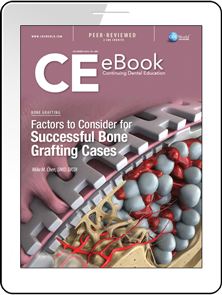Factors to Consider for Successful Bone Grafting Cases
Released: Monday, December 12, 2016
Expires: Tuesday, December 31, 2019
By Mike M. Chen, DMD, DICOI
Commercial Supporter: Sunstar Americas, Inc
The most common bone defects that dentists may encounter today and which may compromise implant treatments are those that are present at extraction sites. Fortunately, extraction site defects can be repaired and/or regenerated using bone grafting materials to restore and maintain bone height and width. However, successful bone grafting is predicated on understanding the basic biologic processes involved and, therefore, the requirements that bone filling materials must satisfy. This article reviews basic types of bone grafting procedures and classifications of bone grafting materials, and illustrates a technique for the use of a new alloplastic bone material in the context of regenerating a socket defect.
LEARNING OBJECTIVES:
-
Describe the three basic biological elements required for bone grafting and guided bone regeneration.
-
Discuss the three classes of extraction site defects.
-
Explain the differences among autograft, allograft, xenograft, and alloplast materials available for bone grafting.
-
Describe a bone filling technique for an extraction site.
About the Author
Mike M. Chen, DMD, DICOI
Private Practice, California Center for Implant Dentistry, San Jose, California
